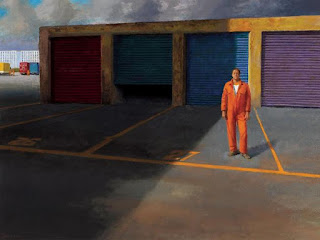 |
| Container Train in Landscape |
 |
| Jeffrey Smart with his last documented painting, "Labyrinth", 2011 |
 |
| Container Train in Landscape (detail) |
He is an
 |
| Yarragon Siding |
 |
| Portriat of Clive James |
 |
| Alma Mahler Feeding the Birds |
 |
| Portrait of David Malouf |
 |
| Bruce Beresford |
 |
| Cahill Expressway |
 |
| Morning Practice, Baia |
 |
| Container Train in Landscape |
Labyrinth (2011), a metre-square picture, is Jeffrey Smart's last documented painting and is exhibited here for the first time. It shows a vast stone labyrinth that stretches to the horizon, with a solitary figure standing in it. It evokes the painter's vision of that maze of back streets that he found so fascinating as a child. This return to the childhood experience that started him on his creative journey, may well be a fitting full stop to the Jeffrey Smart oeuvre.


No comments:
Post a Comment